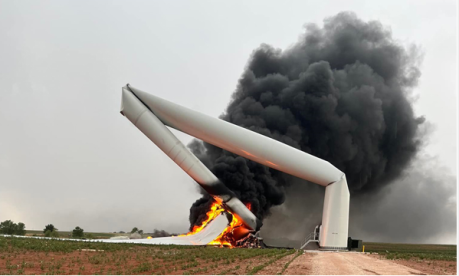
Wind industry spin doctors are struggling to explain away a troubling uptick in catastrophic and terrifying wind turbine collapses. Gravity is not kind to these 300-tonne monsters; hundreds of them have collapsed around the world and the rate of collapses appears to be increasing, over time.
Over the last few years, there have been hundreds of ‘structural failures’ – where either 10-15 tonne blades are shredded or flung in all directions; or their 90-100m towers implode, unceremoniously delivering the 80-100 tonne nacelle to terra firma, with exhilarating effect.
Then there are the hours-long pyrotechnic displays when these things self-immolate; exploding into balls of flame and toxic smoke and sending a shower of molten metal and over 1,000 litres of flaming gear oil, hydraulic fluid (see our post here) and burning plastic composites earthwards. By the way, wind turbine fires are ten times more common than the wind industry and its parasites claim (see our post here and check out this website: http://turbinesonfire.org).
Then there are occasions when they manage to combine one or more of their frightening characteristics, at once – bursting into flame then collapsing (see above); collapsing and bursting into flame, or throwing off their 60m blades while on fire.
Thomas Lifson gives us an exciting update on what your wind ‘powered’ future will look like.
Huge wind turbines — taller than the Statue of Liberty — are toppling over in a ‘rash’ of incidents
American Thinker
Thomas Lifson
23 January 2023
Bloomberg Business Week, no foe of green energy, headlines: “Wind Turbines Taller Than the Statue of Liberty Are Falling Over.” The article beneath the headline reports on a variety of alarming disasters involving wind turbines, including collapses of very tall structures:
On a calm, sunny day last June, Mike Willey was feeding his cattle when he got a call from the local sheriff’s dispatcher. A motorist had reported that one of the huge turbines at a nearby wind farm had collapsed in dramatic fashion. Willey, chief of the volunteer fire department in Ames, 90 miles northwest of Oklahoma City, set out to survey the scene.
The steel tower, which once stood hundreds of feet tall, was buckled in half, and the turbine blades, whose rotation took the machine higher than the Statue of Liberty, were splayed across the wheat field below. The turbine, made by General Electric Co., had been in operation less than a year. “It fell pretty much right on top of itself,” Willey says.
Another GE turbine of the same model collapsed in Colorado a few days later. That wind farm’s owner-operator, NextEra Energy Inc., later attributed it to a blade flaw and said it and GE had taken steps to prevent future mishaps. A spokesperson for GE declined to say what went wrong in both cases in a statement to Bloomberg.
The instances are part of a rash of recent wind turbine malfunctions across the US and Europe, ranging from failures of key components to full collapses.
The article blames the “rash” of incidents on the rush to install turbine capacity, but there are also permanent factors that make engineering, building, and maintaining wind farms difficult and risky. To develop meaningful amounts of power, the blades on the turbine have to be big, and when big blades spin in heavy winds, the tips can end up hitting supersonic speeds, putting great stress on the materials used to construct them. Big blades also requite tall towers, which are then subject to stresses as winds blow and can gust during storms to velocities that test the strength of the materials and the design of the towers.
And, of course, tall, string towers require a lot of construction materials that have (ahem) a considerable carbon footprint to create. Compared to the amount of “carbon free” electricity generated, the carbon emitted in manufacturing and construction of the towers may take many years to counterbalance. Consider that the relatively low electricity production of each tower (compared to a coal or nuclear fired plant) means that far more power transmission lines must be constructed, and there is a carbon footprint involved, not to mention the excess demand created for copper, which has its own environmental issues in mining and refining, and the problems with meeting demand when creating new copper mines hits a high wall of resistance from the very same environmentalists who think windmills are a solution to the problems they imagine CO2 creates.
But with wind farms, longevity is an issue. The unpredictable nature of winds, with the speed and direction changing abruptly, means that complex transmission boxes must be attached to each turbine, and these transmission boxes are stressed when high winds occur and suddenly change direction. They need maintenance crews at the ready. In my consulting days, I encountered a wind farm project whose transmission boxes regularly exploded when sudden gusts of wind over-stressed them, creating their own mini environmental disasters from the transmission fluids spewed onto the ground.
All of these problems are in addition to the fundamental problem with wind energy: it is unreliable. When the wind doesn’t blow, you get no electricity, so you still need backup generating power at the ready, and that usually involves carbon-based fuels, since constructing nuclear plants is so rare these days.
Then there are all the millions of birds, including the federally protected bald eagles, that are killed each year by windmills.
Wind farms, in other words, are one of the worst options for providing electricity.

